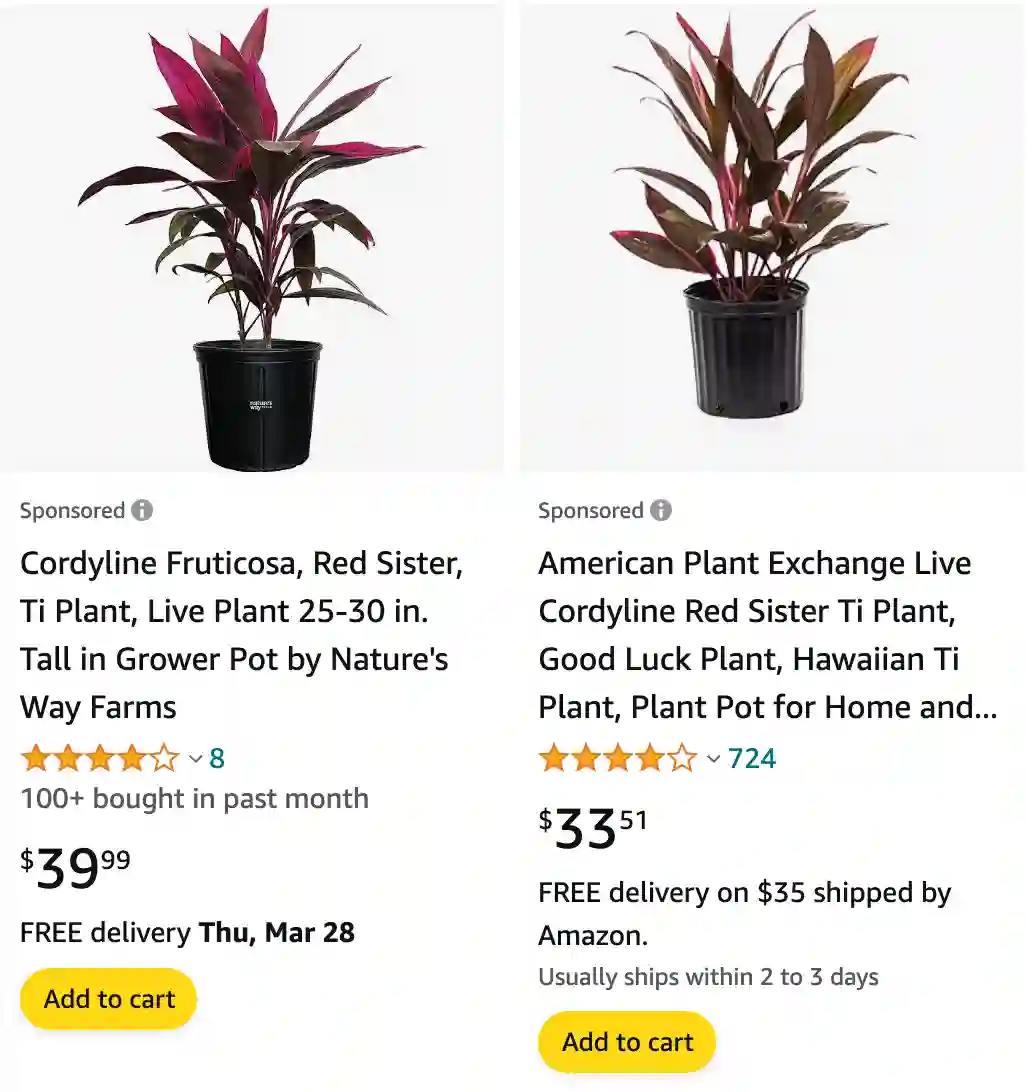
How to care for Cordyline Red Sister?
Here’s a guide on how to care for your Cordyline Red Sister, also known as the Hawaiian Ti plant, and keep its vibrant red foliage thriving:
25 Species in Genus Cordyline
Light:
- Cordyline Red Sister prefers bright, indirect sunlight. This will promote healthy growth and maintain the rich red color of the leaves.
- Avoid strong direct sunlight, especially during the hottest parts of the day, as it can scorch the leaves. Lower light can be tolerated, but the red color might be less intense and the plant might grow leggy.
Watering:
- Water regularly, keeping the soil consistently moist but not soggy. Overwatering is a major threat to Cordyline Red Sister.
- Here’s how to check moisture: Stick your finger into the top inch of soil. If it feels dry to the touch, it’s time to water.
- Allow the top inch of soil to dry out slightly between waterings.
Soil and Drainage:
- Well-draining soil is essential. A good quality potting mix or a mixture of potting soil with added perlite or sand works well.
- Ensure your pot has drainage holes to prevent waterlogging.
Fertilizing:
- Fertilize sparingly during the growing season (spring and summer) only. Apply a balanced liquid fertilizer diluted to half strength once a month or a slow-release fertilizer formulated for houseplants according to package instructions.
- Avoid overfertilizing, as it can damage the roots.
Temperature and Humidity:
- Warm temperatures between 60-80 degrees Fahrenheit (15-27 degrees Celsius) are ideal. Protect your plant from cold drafts and sudden temperature fluctuations.
- Moderate humidity is beneficial. While Cordyline Red Sister is not as fussy about humidity as some houseplants, dry air can cause brown, crispy leaf edges.
- You can increase humidity by:
- Misting the plant occasionally with lukewarm water (avoiding the center of new growth)
- Using a pebble tray filled with water (ensure the pot sits above the water level)
- Grouping your Cordyline Red Sister with other humidity-loving plants
- Using a humidifier
- You can increase humidity by:
Additional Tips:
- Wipe the leaves occasionally with a damp cloth to remove dust and improve light absorption. Avoid harsh chemicals or cleaning products.
- Cordyline Red Sister is a relatively slow grower. Don’t be discouraged if it doesn’t put out new leaves frequently.
- Watch out for common houseplant pests like mealybugs and spider mites. Neem oil solution or insecticidal soap can be used for control if needed.
- Cordyline Red Sister can mature to 8-10 feet tall outdoors in tropical climates. As a houseplant, it may reach 3-4 feet and can be pruned to maintain a desired size. Use sharp, sterilized pruning shears.
Are Red Sister Cordyline poisonous to dogs?
Yes, Red Sister Cordyline plants are considered toxic to dogs if ingested. It’s best to keep them out of reach of pets to prevent accidental ingestion.
How to prune Cordyline Red Sister?
Prune Cordyline Red Sister by removing any dead, damaged, or diseased leaves as needed to maintain a tidy appearance. You can also trim back leggy or overgrown stems to encourage bushiness. Use sharp, clean pruning shears and make cuts at a 45-degree angle.
Is Red Sister Cordyline a perennial?
Yes, Red Sister Cordyline is a perennial plant, meaning it can live for several years under the right growing conditions.
Can a Red Sister Cordyline plant be kept indoors?
Yes, Red Sister Cordyline can be grown indoors as a houseplant, provided it receives bright, indirect light and is planted in well-draining potting mix. Keep the soil evenly moist and mist the foliage occasionally to maintain humidity.
Can you plant Red Sister Cordyline in a flower bed?
Yes, you can plant Red Sister Cordyline in a flower bed as long as the soil is well-draining and receives adequate sunlight. It adds a dramatic focal point and tropical flair to garden beds and borders.
How to deadhead Red Sister Cordyline?
Deadheading is not necessary for Red Sister Cordyline. Simply trim off any dead or yellowing leaves as needed to maintain the plant’s appearance and health.
Is Red Sister Cordyline poisonous to cats?
There is limited information available regarding the toxicity of Red Sister Cordyline to cats. However, given its potential toxicity to dogs, it’s advisable to keep it away from cats as well.
What soil to use for Red Sister Cordyline?
Use a well-draining, fertile potting mix for Red Sister Cordyline, preferably one designed for tropical plants. You can also amend garden soil with compost or peat moss to improve drainage and fertility. Avoid heavy clay soils, as they can lead to waterlogging and root rot.
If i die, water my plants!



